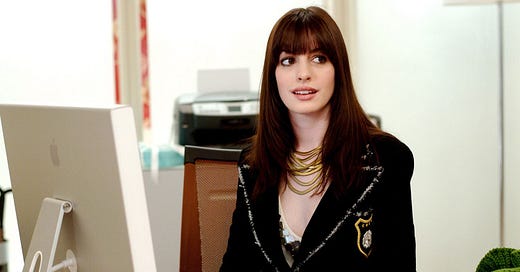Magazine Girls Cinema
What would Andy Sachs and other fictional media mavens be up to today? We've got some thoughts.
Not too long ago, the Magazine Girl was everywhere, breezing through popular culture in books, movies and TV shows. She was plucky and determined! She turned the world on with her smile! Sometimes her name was Andy. Other times it was Andie.
Magazine Girl still has cultural relevance — The Devil Wears Prada remains an internet fixation and The Seven Husbands of Evelyn Hugo, a novel in which a features writer interviews a movie star, has spent a whopping 110 weeks on the New York Times best-seller list. But in the here and now, in the real world, glossy print titles no longer have the power they once did. As media empires like Condé Nast pivoted to focus on bolstering digital brands, Instagram became the new magazine, publishing pretty pictures and long captions by the millisecond. Jobs were less safe as layoffs loomed — even Laura Brown, the beloved editor of InStyle, lost her position last year when the glossy folded. One after another, Condé fashionistas have departed Anna Wintour’s kingdom. Eva Chen quit Lucky to lead Instagram’s fashion partnerships and Vogue’s Selby Drummond joined the dating app Bumble. Lauren Santo Domingo, who launched the high-end retail dot com Moda Operandi in 2010, was one of the first high-profile Voguettes to embrace e-commerce.
Other magazine girls do not have luxury backgrounds to fall back on, and so they get scrappy. They diversify. They land consulting contracts. They pen thriller novels. They spice up corporate marketing copy. They ghost-write Ted Talks. They join TikTok. They start a Substack. They go back to school. My friend and mentor Jennifer Keishin Armstrong, an iconic byline from Entertainment Weekly’s heyday, now writes brilliant books about pop culture, including So Fetch, the inside story of Mean Girls, which arrives next year. She recently started the newsletter Culture Trip, which explores psychedelics’ colorful history.
The other day, Jennifer and I got on the subject of Magazine Girls Cinema. How, we wondered, would Anne Hathaway and Kate Hudson and Jennifer Garner adapt in this rapidly changing media landscape? (Back off, ChatGPT!) We present an old-school listicle with our predictions. —EC
Andy Sachs, The Devil Wears Prada (2006)
Seventeen years later (!!!), Prada remains the ultimate Magazine Girl Movie. It sets the standard for the subgenre, and yes, much of that has to do with Meryl Streep’s chilling performance as Miranda Priestly, the sadistic editor of the fictional fashion bible Runway, a Vogue surrogate. But let us not discount what Hathaway brings to the most perfect role of her career: She is Miranda’s tortured assistant, Andy, a naive Northwestern grad who lands the plum nightmare job that a million girls would kill for. She must endure panicked Starbucks runs, the humiliation of The Cerulean Speech and the ridiculous task of delivering The Book to Miranda each night.
Spoiler alert: Andy winds up being very good at managing up to Miranda! So good, in fact, that Miranda lets her tag along to Paris Fashion Week. The glamorous trip takes a dark turn, however, when Andy witnesses Miranda betray Runway lifer Nigel (Stanley Tucci) out of self-preservation. She decides that she will not sell her soul to work for Miranda and dramatically walks away from the editrix, leaving her without a gopher. Afterward, we see a casually dressed Andy interviewing at an unpretentious New York City publication that seems more her speed. Or so we think.
What she’d be up to now: In Revenge Wears Prada: The Devil Returns, author Lauren Weisberger’s 2013 sequel to the roman à clef on which the film is based, we learn that Andy, still drawn to the glam life, is the founder of a bridal glossy called The Plunge. But that was a decade ago. Ancient history. Condé sold The Plunge to the online publisher Dotdash, which ended the print run and turned the brand into a Pinterest board. Afterward, Andy left the ruthless media world behind to open a quaint travel bookstore in Cobble Hill inspired by Hugh Grant’s in Notting Hill. Passersby laugh when they first see it. Who needs travel books anymore? they ask. All the information you need is just one click away. Once the skeptics step inside, though, they discover a delightful, wholesome portal to a simpler time. “She is utterly enchanting!” they say of Andy, renowned for her impeccable taste. One day, Andy’s former Runway colleague Nigel, a free agent ever since his social media exploded during the pandemic, visits and buys several Rick Steves guides. “I’m doing a bit of research for my upcoming CNN travelogue, Searching for France,” he explains, breaking into a giant grin. “You should appear in an episode or two! Filming begins next month. Meet me in Paris? This time, we’ll really get to enjoy it.” —EC
Jenna Rink, 13 Going on 30 (2004)
Jennifer Garner is outrageously charming as a 13-year-old who’s found herself transported, via birthday wish, into her 30-year-old life and body. Good news: She’s living her dream as a magazine editor. Bad news: She finds out that she grows up to be terrible.
Spoiler alert: Young Jenna tries to fix Terrible Old Jenna’s life by being nice and reconciling with her childhood friend Matty (Mark Ruffalo) and snagging the editor-in-chief job at Poise magazine with an earnest and weirdly high school-themed rebrand. But then she wakes up back at 13, gives up on being popular, kisses Matty and … ends up married to him and living in a house that looks like her childhood doll house? And this is … good?
What she’d be up to now: I’m leaning into this alternative Jenna from the ending: She’s repressed her magazine editor dreams for this domestic lifestyle, so what else could she be but a momfluencer? She’s sweet on the outside, but cutthroat when she needs to be; we know she’s got it in her from her other timeline. She invented momfluencing, starting with a blog that she built into a network of blogs. Now she has a team that helps her to dominate Instagram and TikTok with perfectly crafted lifestyle videos. No one is sure if and how she makes money, but luckily Matty ended up being a high-fashion photographer who can pay the bills. —JKA
Andie Anderson, How to Lose a Guy in 10 Days (2003)
Kate Hudson plays a women’s magazine writer who “pretends” to fall in love with Matthew McConaughey’s Benjamin Barry (so much alliteration!), then proceeds to try to get him to break up with her within ten days for a blockbuster article at her magazine Composure. (LOL at these mag names.) This is obviously insane, but, in her defense, this guy has also made a bet that he can make a woman fall in love with him in ten days, so they’re a perfect psychopathic match.
Spoiler alert: They end up going to a fancy company event where she wears an incredible butter-yellow gown, and they break up. But she saves the relationship by writing a confessional piece in which she says she loves him, then quits her job because she really wants to write about “serious topics.” Somehow this all leads to them kissing on the Manhattan Bridge.
What she’d be up to now: Yeah, yeah, serious topics, but how could she resist when agents and editors persuaded her to write a chicklit book—so hot in 2003—loosely based on her time at Composure? It was a bestseller, and she cranked out a few more books with pink covers before the genre tanked. After a stint at xoJane, she transitioned to being a freelance writer/Instagram influencer who dispenses dating advice and sells rosé and pink leggings designed to be flattering on women over 40. She does not actually do much freelance writing, but sometimes she’s interviewed about her favorite makeup/skincare/exercise routines. She never got around to “serious topics.” —JKA
Amy Townsend, Trainwreck (2015)
Twist! Amy Schumer’s character writes for a men’s magazine, though she definitely missed the 2000s heyday. (I would have given anything to work at GQ in 2005.) She meets a sports doctor played by Bill Hader and falls in love, despite her belief that monogamy is BS.
Spoiler alert: After they break up and the article is killed, Amy pulls it together and sells the story to Vanity Fair. She sends him the story and makes a killer grand gesture, performing “Uptown Girl” with the Knicks City Dancers at a game he’s attending at Madison Square Garden.
What she’d be up to now: I like sports as a subject matter, longevity-wise, and I like her chutzpah. I say she’s a rare media survivor, freelancing for Vanity Fair as well as Sports Illustrated. Congrats, Amy, for being one of the few still getting paid $1-2 per word to write actual articles, not listicles or blurbs, filled with actual reporting. Her piece on sports and microdosing undoubtedly made a big splash! —JKA
Susan Orlean, Adaptation (2012)
Meryl has a ball playing a meta version of The New Yorker scribe Susan Orlean in Adaptation, director Spike Jonze’s wildly inventive collaboration with screenwriter Charlie Kaufman. Meanwhile, Nicolas Cage channels a meta-Kaufman struggling to adapt Orlean’s real-life nonfiction book The Orchid Thief. He invents a romance between Orlean and her subject, horticulturalist John Laroche (Chris Cooper), who poaches rare orchids from a nature preserve in south Florida. In Kaufman’s revisionist history, Laroche introduces Orlean to a trippy drug that causes fascination. The sequence where Meryl is high, directing Cooper to harmonize a dial tone, is oddly sweet!
Spoiler alert: A crazed Orlean catches Kaufman spying on her, and kidnaps him at gunpoint, homicide on her mind. They drive to a swamp, where Kaufman escapes and an alligator kills Laroche. Orlean gets arrested — a cautionary tale of a reporter getting way too close to a source.
What she’d be up to now: After doing time with good behavior, I imagine this faux “Susan Orlean” returning to The New Yorker as a legacy staff writer. She maintains a popular and unhinged social-media presence, posting Instagram selfies from her Brooklyn bathtub. On Twitter, to her fangirls’ delight, she announces that she will cook through Ottolenghi’s Plenty, one recipe at a time, and document the dishes each day. Two years pass before she posts a photo of a croissant she saw at the chef’s London bakery. She spends most of her days at the New York Public Library researching a book about the lost art of calligraphy that will be published in the year 2045. —EC
Rachel Samstat, Heartburn (1986)
Again with Meryl! Here, the shape-shifter impersonates literary icon Nora Ephron in the film adaptation of Ephron’s autobiographical novel about the scandalous end of her marriage to Watergate prince Carl Bernstein. In Heartburn the movie, fancy food writer Rachel Samstat discovers that her husband Mark (Jack Nicholson), a political journalist, has cheated on her while she is pregnant with their second child. Drama!
Spoiler alert: But also, comedy. The glorious moment when a fed-up Rachel smashes a key lime pie into Mark’s face at a dinner party is a prime example of The Tao of Ephron. If something bad happens to you, find a way to make it funny. Then you can spin the narrative in your favor, becoming the hero rather than the victim. Liberated, Rachel takes her kids and leaves Mark in D.C., embarking on her new life as a single mother.
What she’d be up to now: Writing collectible cookbooks from the Hamptons home she shares with her third and best husband, Nick Pileggi. (Obviously.) —EC
Well, this was fun! If you enjoyed it, give it a “like,” won’t you? Yours in bouquets of newly sharpened pencils, Erin and Jennifer.







This is maybe the most creative piece I've ever read on substack..... loved it sm 😭 (magazine girls cinema = best movie genre FR)